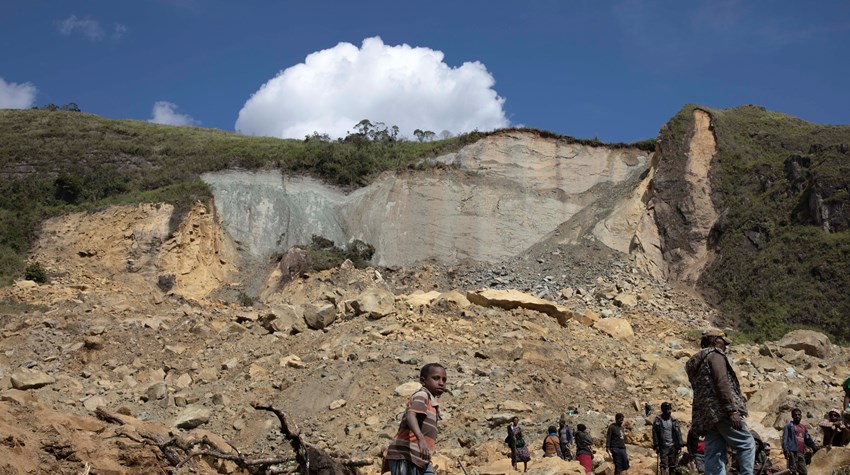Early in the morning of 24 May 2024, a massive landslide in Enga Province, PNG, claimed the lives of an estimated 640 to 2000 people. Villages and vital infrastructure were destroyed in its wake and thousands were displaced by the disaster. The landslide devastated food gardens, as well as roadways for safe passage of essential goods.
In the months following the disaster, RedR Australia worked closely with UNDP to support relief and recovery efforts for affected communities.
Deployed with UNDP, roster member Swapnil worked alongside communities and the local government to create a recovery plan.
A plan for recovery
When Swapnil arrived in PNG, two months after the landslide, the enormity of the disaster was still very evident.
“When I arrived, the impacted community from Tuliparo village was still displaced and grieving,” said Swapnil. “There was a temporary care centre set up and basic services were being provided.
“Despite being two months from the crisis, there was still a strong sense of the immediate impact of the disaster still being prevalent.”
As an early recovery advisor with UNDP, Swapnil worked closely with the Enga Provincial Government, UNDP team and local community to prepare an action plan. Named the Mulitaka Disaster Recovery Plan, it is owned and implemented by the Enga Provincial Government. The plan supports the relocation, reconstruction and recovery of livelihoods for communities affected by the landslide.
Swapnil explained that this plan is central to recovery efforts.
“The plan is the foundational document that sets up the relocation authority and process for displaced households,” said Swapnil. “It is driving the land survey and sub-division process at the new relocation site.”
With humanitarian and early-intervention experience across Asia, the Pacific, Europe and the Middle East, Swapnil was well prepared to work quickly and collaboratively to prepare the plan.
“Having worked extensively with national and provincial governments in the Pacific before, I was well equipped to deal with the particularities of the context in the Highlands of Papua New Guinea,” he said
Working to prevent future landslides
With large swathes of mountainous terrain, PNG is vulnerable to landslides. With this in mind, Swapnil worked to ensure the recovery plan also included interventions to prevent further landslides in the region.
“Specific interventions include re-forestation and re-vegetation of unstable, landslide-affected slopes using native vegetation,” said Swapnil.
“Other interventions included the construction of living retaining walls and bio-engineered slope-stabilisation solutions for unstable landslide-affected areas.”
The plan seeks to reduce future landslide risks at resettlement sites and promote the formation of community-based agro-forestry groups.

“While I was at the site, I was reviewing the damage that had occurred to residential structures and reviewing the proposed sites for renovation and re-construction”, Swapnil said (pictured centre).
Collaborating for success
In November, the Enga Provincial Government launched the completed Mulitaka Disaster Recovery Plan, supported by the UNDP Resident Representative, Mr. Nicholas Booth. This was the culmination of a huge amount of work by government officials, Swapnil and the UNDP team. And at its heart was partnership.
"Our ongoing partnership with the Enga Provincial Government reflects a shared commitment to support those most affected, to restore hope, and rebuild lives of the people of Mulitaka and Enga Province,” said Mr. Booth.
“This plan focuses on the critical priorities for the recovery of those communities impacted by the landslide and will also take into consideration the broader long-term development goals for the province.”

The plan was officially initiated in Wabag on 13 November 2024. Photo: Seru Kepa | UNDP Papua New Guinea
Swapnil also stressed the critical work of the Enga Provincial Government in the development of the recovery plan.
“The success of my deployment was in large part due to the Enga Provincial Government, who were extremely motivated and—despite limited capacity—worked hard to develop the plan alongside me,” said Swapnil.
“It was their demonstrated commitment that led to its timely development and launch.”
Swapnil also commended the local community for its strength and resilience.
“Engans are resilient in the face of disaster and I was inspired by their ability to bear the tragic circumstances of the landslide with dignity,” he said.
Learn more about the work of RedR Australia’s roster members.


